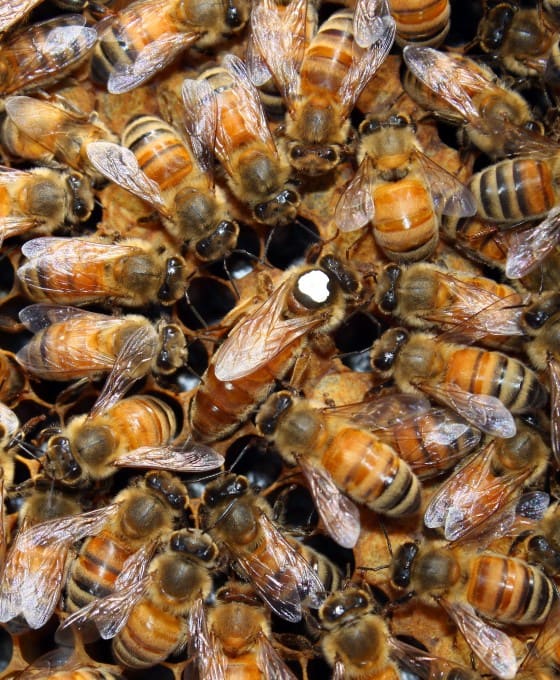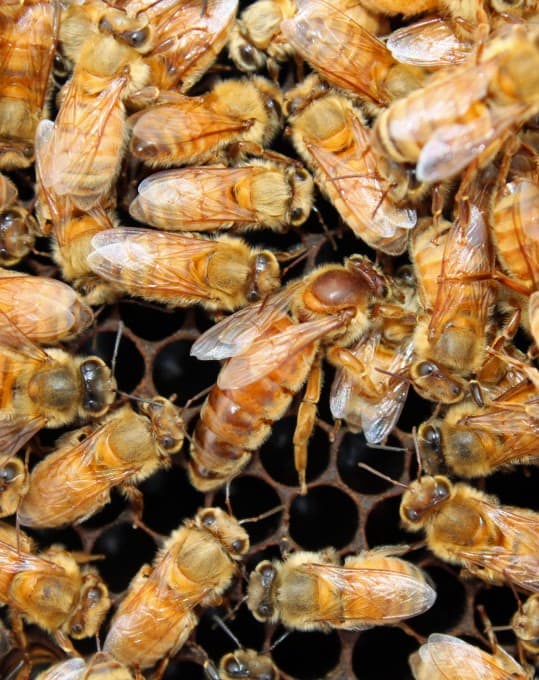The Italian bee – also known as Apis mellifera ligustica or A.m.ligustica for short – is perfectly adapted to the Italian climate and flora and a very glamorous bee altogether.
As you can see from this photo, borrowed from http://beeinformed.org, it is mainly light brown in colour and strikingly striped with dark brown on the abdomen.

As you would expect, it has its origins in Italy and is well adapted to the warm Mediterranean climate but it can also do well further north. The great beekeeper Johann Dzierzon – he of beespace fame imported them to Poland and worked them there for many years. They were also much imported to England and Ireland for a time as they do have many admirable qualities:
- In a good year they will bring in enormous crops of honey.
- They are very placid and easy to handle.
- They have a low swarming instinct.
- They also have a long proboscis which means they can take full advantage of the red clover which is a flower with a very deep throat.
They fare less well when the weather gets shitty though, and for a number of reasons:
- They are smaller, slimmer bees so less able to maintain body temperature.
- They bring in less propolis which makes them easier to work but in a cold, windy winter they might feel the draughts whistling round their ankles.
- They continue to breed very late in the year and as a result go into the winter with large colonies and many mouths to feed. Then they start to build up again very early – another drain on precious stores in the chilly north. They are renowned for the amount of stores they will go through in the winter.
- They drift and they rob;
- Small Hive Beetle has been found in Italy so before you go importing Italian bees or buying bees from someone who imports Italian bees – think about what else you might be importing. Click here for more on Small Hive Beetle;
- Also bear in mind – if you are outside Italy, you will only have Italian bees for one year – after that you will have mongrel bees because they will interbreed with your neighbour’s native bees and you will have to consider re-queening with more imported queens every year.
- And you will mess up your neighbour’s breeding programmes.
Cordovan Italians are a paler variant and as you can see from the picture below, again from beeinformed.org they are very beautiful and almost yellow.

I saw these once, they were working the blackberry, along with a number of their dark brown A.m.mellifera cousins, in south east England. I could hardly believe my eyes – they really are this pale.
Protection for Local Bees
In parts of Italy, breeders of Italian bees are tearing their hair out because people are importing foreign and totally inappropriate bees there and messing up the gene pool. In the Emilia Romagna region, the beekeepers have managed to declare a reserve for the Italian bee so it can be protected from extinction by hybridisation.
This is the same problem we have in Ireland and the Native Irish Honey Bee Society (NIHBS) is working towards similar protection for Apis mellifera mellifera.
Click here for more about the Native Irish Bee
Click here for updated list of Irish Native Honey Bee suppliers
Click here for the Grey bee – Apis mellifera carnica
Click here for the hybrid Buckfast bee
Copyright © Beespoke.info, 2014. All Rights Reserved.